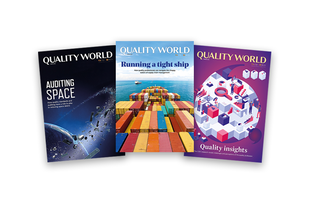
Top tips for problem solving with ISO 9001:2015
Progress indicator

David Finney, CQP MCQI, founder of The Energy of Conversation and trainer in coaching and auditing, shares his top tips for problem solving, while meeting the requirements for ISO 9001:2015.
I’ve been training professionals in coaching and auditing skills for many years. When I discuss internal issues arising in business I constantly come across the same two themes – a lack of resources and a lack of communication.
During these conversations it becomes clear that organisations are rich with talented individuals who are highly motivated to make improvements, but are possibly missing some problem solving techniques.
Throughout my career, I have come across several methods for problem solving and typically everything starts with a conversation. Here are some of the methods I think are the most effective.
One problem we face each day is how to effectively prioritise. Bryan Tracey’s ABCDE method facilitates the slicing of tasks into priority groups based on risk, with ‘A’ tasks being top priority.
This is great for managing risk and can be a useful way to approach ISO 9001:2015 Clause 6.1.2, which says: 'Actions taken to address risks and opportunities shall be proportionate to the potential impact on the conformity of products and services.'
Tracey gives each task a letter, to help you prioritise:
A – ‘Very important’ tasks you must do or there could be serious negative consequences.
B – ‘Important’ tasks you should do or there may be minor negative consequences.
C – ‘Nice to do’ tasks that have possible motivational factors but no negative consequences.
D – Tasks that should be ‘delegated’ – seek help if you feel you should not be involved in the task.
E – Tasks that should be ‘eliminated’, this is a chance to remove tasks if they hold no value or opportunity.
Try on a new hat
Edward de Bono created a skilful method of promoting creativity in problem solving using a structured and fun way of talking through an issue. The process requires a facilitator and the ‘hats’ can be virtual or represented by images.
Each hat signifies a stage in the problem-solving process. First, everyone puts on the blue hat to look at the big picture and then they try on each hat, in turn, to focus everyone on thinking in a detailed cohesive way during each phase of the process.
ISO 9001:2015, Clause 5.1.1, emphasises the importance of engaging, directing and supporting people to contribute to the effectiveness of the quality management system. Using the six thinking hats technique fosters this engagement and enables a 360-degree perspective and input from those involved in the process.
A hat is assigned to each step in the process:
Blue hat – What is the issue? What is the scope of the discussion?
White hat – What do we know for sure? What data is available to us? Only review the facts during this phase.
Red hat – What do we feel? What is our gut feeling? Focus on emotions in this phase.
Green hat – What ideas do we have? What could we do? Creativity only in this phase, there should be no criticism or cynicism and anything goes, the more outlandish the ideas the better.
Yellow hat – What benefits might some of these ideas bring? What advantages do they have? Be optimistic and positive in this phase.
Black hat – What concerns do we have over the ideas expressed? How practical are they? What expense might be involved? Don’t be afraid to challenge ideas.
Blue hat – The team should return to the blue hat and ask: where are we in addressing the issue? Has the scope widened? Do we have a solution or a path to a solution?
Think positively
Motivating your team is vital when things appear to go wrong in a process. Appreciative coaching consists of gathering the team together and spending an hour simply talking about what is going well to accentuate the positive.
Taking time out to appreciate the strengths of the people in the team, the software, the hardware, all aspects of the process can be very motivational and might just lead to opportunities to make improvements.
For example, I have seen a team recognise good practice in one area and implement it in another area as a result of this technique, helping them to determine opportunities for improvement (ISO 9001:2015, Clause 10.1).
Ask ‘why?’
One of the most common reasons for mistakes is human error but does that make us lazy and is that always the root cause? The Five Whys technique finds the root cause of a defect by encouraging the team to answer the question ‘why?’ five times, leading to the deeper cause of the problem.
Let’s look at an example: an IT Support company defines an incident as a customer reporting a software or hardware fault and has two key performance indicators – the number of incidents reported each month and the number of hours it takes to resolve an incident.
A customer makes a complaint that their email kept crashing after a new software version was installed and said it took almost three days to resolve it.
The company investigated the complaint by interviewing the support team leader who said the engineer had made a mistake by mistyping the completion date. So, should you stop here and call it a nonconformity due to human error or ask more questions?
By delving deeper it turns out the software should not have allowed a completion date of more than 48 hours.
These techniques emphasise the importance of conversation and a driving factor is asking the right questions to ensure the right results.
However, with the recent release of ISO 9001:2015, risk-based thinking could turn out to be the biggest problem solver yet, because there is no better solution for a problem than to stop it from ever being a problem in the first place.
Learn more about implementing ISO 9001:2015 in line with risk based management.
Member only

This article is free to access for a limited time only. Only CQI and IRCA members receive access to all content.
Find your membership grade
Take this short quiz to find out which CQI membership grade is right for you
Get the latest ISO reports and resources

Our many reports and resources will help you achieve a smooth transition to ISO 9001:2015 and ISO 14001:2015.